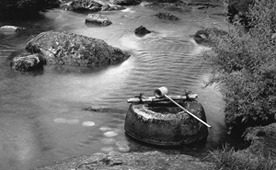

Ueji, The Genius of Water and Stone (Part 2 of The Great Masters of Japanese Gardens),
Kyoto Tsushinsha, 120 pp.
The 7th generation Ogawa Jihei (1860-1933), better known as “Ueji,” was a magician with water and stone and a pioneer of modern Japanese garden design. This bilingual book, stocked with quality photos, introduces in detail Ueji’s most famous gardens — their spatial arrangement, design and features. The book follows Part 1 of The Great Masters of Japanese Gardens series, on Shigemori Mirei.

Generously supported by political and financial power-brokers such as Yamagata Aritomo, Ueji used the Okazaki district in Kyoto to situate many of his works, taking advantage of the clean water brought from Lake Biwa, and using the Higashiyama mountains as a backdrop. Many of these gardens still remain. Incorporating into his designs waterfalls, streams, ponds, as well as numerous water basins, Ueji’s works give a sense of pure beauty and rhythm. Ueji’s skill can be seen in the many ways he applies stones along garden paths, as well as his rock groupings (particularly with waterfalls). Ueji expressed Japan’s beauty through the garden, the highlights of which are captured here by the photographs.
Although slim, this book introduces Ueji’s most well-known works, including the Hekiun-so Garden (Nomura Villa), Murin-an Garden, Heian Shrine, and Maruyama Park. Along with the gardens, there is a steady stream of interviews with specialists from various fields, giving a broader impression of Ueji’s works. For Japanese readers, there is a timeline of the designer’s life, and an excellent glossary of Japanese gardening terms. English translations of all the text, interviews, as well as directions to the featured gardens in Kyoto, however, make this volume a must-have for those who wish to learn more about a master of modern Japanese garden design, Ueji.
This review was translated by Eric Luong.
Available online in English & Japanese at:
http://www.kyoto-info.com
